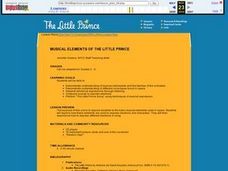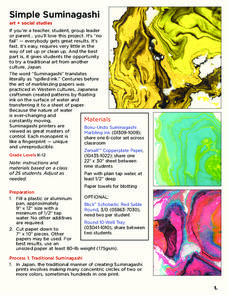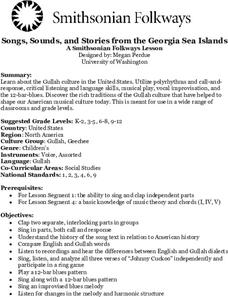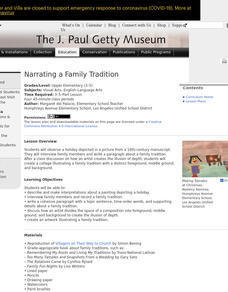Curated OER
MUSICAL ELEMENTS OF THE LITTLE PRINCE
Students demonstrate knowledge of musical instruments and the families of the orchestra. They acknowledge different voice types found in opera. Students interpret emotional expressions through listening. They compose sounds to express...
Curated OER
Expanded Images
Allow your young artists to use their imagination with this fun art project! Cut out various images from a magazine to be the spark to your artists' creativity. Have them glue an image onto a piece of paper, then draw a backdrop to go...
Curated OER
Souper Art
Turn your young artists into great marketing specialists with this fun lesson plan! They will turn ordinary soup cans into exciting choices for dinner by recreating the can label. This is a fantastic project to connect art, advertising,...
Curated OER
Simple Suminagashi
What a wonderful way to meld art and culture! Learners create art work in the Suminagashi style using this detailed lesson plan. This art form, which is Japanese in origin, employs ink to create beautiful results. This will be a hit with...
Curated OER
SIGHT READING RHYTHM PATTERNS
The perception of rhythms by reading and the ability to auditorily discriminate these rhythm patterns by listening to them performed by the teacher is practiced here. your students will work to create an eight-beat long rhythm pattern.
Curated OER
The Blues, B.B. King, Muddy Waters
B.B. King and Muddy Waters are two of the most famous blues performers of all time. In this music lesson, middle schoolers study the early careers and lasting musical contributions of both artists, each of whom carried the blues on to...
Curated OER
Melodic Phrases
Melodic phrases in pieces of music are the focus of this music instructional activity. Young musicians study melodic phrases in vocal and instrumental music pieces. They listen to a variety of musical examples in order to identify the...
Curated OER
Water, Art, and The Canadian Identity
Have your class explore the representation of water in Canadian art. This lesson has learners investigate the representation of water in a variety of art forms. They focus on their personal feelings about art and the topic of water. What...
Curated OER
When Art's a Craft
What would it be like to restore modern works of art? By acting as modern art conservators, learners assess the first-hand difficulties faced in restoration efforts. In addition, they create modern art pieces from random materials. Then,...
Curated OER
Springfield Digital Storytelling Project #6: Grapes Commercial
Here is a fabulous instructional activity that should have your class very excited! They utilize the GRAPES formula in order to produce a commercial like ones we see on TV. Working in pairs, they must come up with a script, take video,...
Julio Foppoli
Tener
Supplement your lesson with this fantastic PowerPoint about the Spanish verb tener. It outlines the different conjugations of the verb, as well as includes ten fill-in-the-blank sentences for your students to complete.
Curated OER
Starry Night
Slowly uncover the famous artwork by Vincent Van Gogh entitled Starry Night. In this PowerPoint, a block of color is revealed as you scroll through each slide. Test to see how many slides it takes for your students to recognize the...
Curated OER
Covering the Issue
Examine how art and music can be powerful tools for conveying a political or social message. After considering the issues surrounding rapper Paris, students design their own album covers that reflect their political and/or social...
Curated OER
Musical Instrument Families
Using graphics, and an easy-to-understand format, this resource outlines the different kinds of instruments and their characteristics. This presentation could be used as an introduction to instruments for young scholars getting ready to...
Smithsonian Institution
Singing for Justice: Following the Musical Journey of “This Little Light of Mine”
Scholars go on a musical journey to discover the origin, importance, and evolution of the song, "This Little Light of Mine". Class members boost their voice talents and clap to the beat while learning the lyrics in both English and Zulu....
Smithsonian Institution
Songs, Sounds and Stories from the Georgia Sea Islands
American music is the result of the influence of many cultures, including the traditions brought by the African slaves. Young scholars study the polyrhythms, the call-and-response format, and the vocal improvisations of the Gullah...
Smithsonian Institution
Jamaican Song, Dance, and Play: Experiences with Jamaican Musical Traditions
Young musicians experience song, dance, and play of the Jamaican culture. Scholars listen for and recreate beats, they play tunes, make up original dances, and play a game that challenges pupils to pass stones to a specific beat.
Smithsonian Institution
African American Music: Let’s Sing and Play Clapping Games
Two lessons focus on making a beat. Using popular African American music of its time, scholars listen and analyze the rhythm then recreate it with hands drums, and cups.
Smithsonian Institution
Spirits Across the Ocean: Yoruban and Dahomean Cultures in the Caribbean Brought by the Slave Trade
Much of Latin American music owes its origins to the slave trade. Peoples from the Yoruban and Dahomean cultures brought with them the distinctive rhythms, time signatures, and eighth note patterns that now characterize Caribbean music....
Smithsonian Institution
The Vocal Blues: Created in the Deep South of the U.S.
Bring the sounds of the deep South vocal blues to the classroom with a Smithsonian Folkways lesson. In preparation, scholars listen to and count the 12 bar blues patterns in several works and identify the I, II, IV, and V chords as well...
Smithsonian Institution
Braiding Rhythms: The Role of Bell Patterns in West African and Afro-Caribbean Music
Africans transported to the Caribbean as part of the transatlantic slave trade brought with them a rich tradition of music and dance. Four lessons teach young musicians the rumba clave rhythm, cascara rhythm, and the 6/8 bell patterns...
J. Paul Getty Trust
Still-Life Painting: Arranging Nature—Lesson 1
Art learners examine still-life arrangement images and respond to a series of prompts. In a whole-class discussion, pupils list elements and qualities that still-life paintings can have. After instructors create an arrangement and model...
J. Paul Getty Trust
Narrating a Family Tradition
After examining a piece of art, scholars discuss what they see, paying close attention to details and space. A read-aloud introduces the topic of family traditions. Pupils interview their family members about a tradition in preparation...
J. Paul Getty Trust
Exhibiting Common Threads
Artists working in different media often explore the same themes—to model how these same themes weave their way through different forms of artistic expression, scholars analyze images by Dorothea Lange, identifying key themes in her...

























